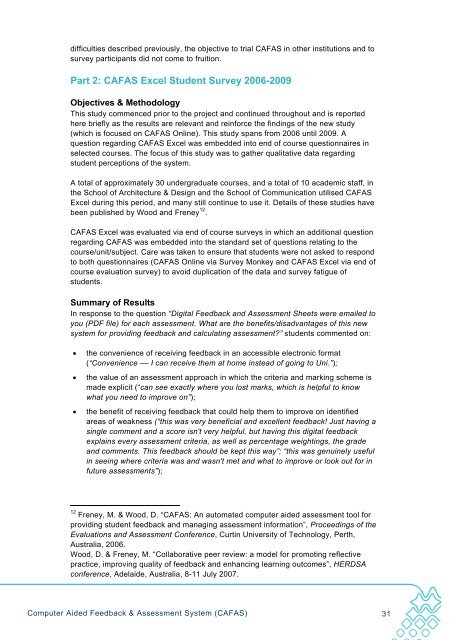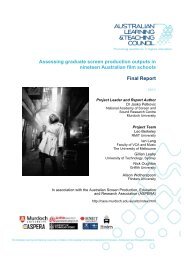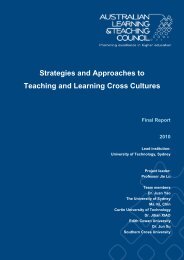PP654 UniSa Freney - Final Report Feb 2010.pdf - Office for ...
PP654 UniSa Freney - Final Report Feb 2010.pdf - Office for ...
PP654 UniSa Freney - Final Report Feb 2010.pdf - Office for ...
You also want an ePaper? Increase the reach of your titles
YUMPU automatically turns print PDFs into web optimized ePapers that Google loves.
difficulties described previously, the objective to trial CAFAS in other institutions and tosurvey participants did not come to fruition.Part 2: CAFAS Excel Student Survey 2006-2009Objectives & MethodologyThis study commenced prior to the project and continued throughout and is reportedhere briefly as the results are relevant and rein<strong>for</strong>ce the findings of the new study(which is focused on CAFAS Online). This study spans from 2006 until 2009. Aquestion regarding CAFAS Excel was embedded into end of course questionnaires inselected courses. The focus of this study was to gather qualitative data regardingstudent perceptions of the system.A total of approximately 30 undergraduate courses, and a total of 10 academic staff, inthe School of Architecture & Design and the School of Communication utilised CAFASExcel during this period, and many still continue to use it. Details of these studies havebeen published by Wood and <strong>Freney</strong> 12 .CAFAS Excel was evaluated via end of course surveys in which an additional questionregarding CAFAS was embedded into the standard set of questions relating to thecourse/unit/subject. Care was taken to ensure that students were not asked to respondto both questionnaires (CAFAS Online via Survey Monkey and CAFAS Excel via end ofcourse evaluation survey) to avoid duplication of the data and survey fatigue ofstudents.Summary of ResultsIn response to the question “Digital Feedback and Assessment Sheets were emailed toyou (PDF file) <strong>for</strong> each assessment. What are the benefits/disadvantages of this newsystem <strong>for</strong> providing feedback and calculating assessment?” students commented on:the convenience of receiving feedback in an accessible electronic <strong>for</strong>mat(“Convenience –– I can receive them at home instead of going to Uni.”);the value of an assessment approach in which the criteria and marking scheme ismade explicit (“can see exactly where you lost marks, which is helpful to knowwhat you need to improve on”);the benefit of receiving feedback that could help them to improve on identifiedareas of weakness (“this was very beneficial and excellent feedback! Just having asingle comment and a score isn't very helpful, but having this digital feedbackexplains every assessment criteria, as well as percentage weightings, the gradeand comments. This feedback should be kept this way”; “this was genuinely usefulin seeing where criteria was and wasn't met and what to improve or look out <strong>for</strong> infuture assessments”);12 <strong>Freney</strong>, M. & Wood, D. “CAFAS: An automated computer aided assessment tool <strong>for</strong>providing student feedback and managing assessment in<strong>for</strong>mation”, Proceedings of theEvaluations and Assessment Conference, Curtin University of Technology, Perth,Australia, 2006.Wood, D. & <strong>Freney</strong>, M. “Collaborative peer review: a model <strong>for</strong> promoting reflectivepractice, improving quality of feedback and enhancing learning outcomes”, HERDSAconference, Adelaide, Australia, 8-11 July 2007.Computer Aided Feedback & Assessment System (CAFAS) 31
















